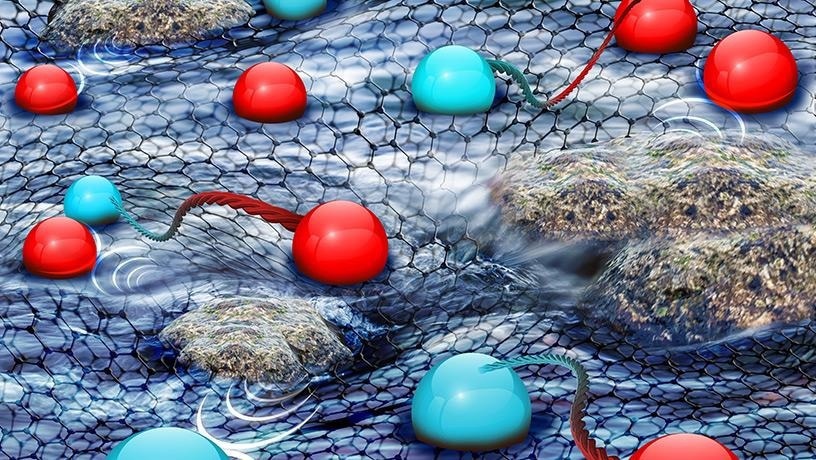Reviewed by Alex SmithJul 21 2022
Although mixing electricity with water is generally not a good idea, the ability of electricity to behave like water could enhance electronic gadgets.
 In a novel semiconductor, electrons can flow like water around obstacles. This hydrodynamic behavior could yield more efficient devices. Image Credit: Rina Goh/National University of Singapore
In a novel semiconductor, electrons can flow like water around obstacles. This hydrodynamic behavior could yield more efficient devices. Image Credit: Rina Goh/National University of Singapore
Recent research from Columbia University's engineer James Hone and the National University of Singapore and Yale-NUS’s theoretical physicist Shaffique Adam builds a new understanding of this unusual hydrodynamic behavior that challenges some long-held beliefs about the physics of metals.
On April 15th, 2022, the work was published in the journal Science Advances.
In the study, the researchers looked at the behavior of a unique semiconductor in which current is carried by both positively and negatively charged “holes” at the same time.
They discovered that this current can be explained by simply two “hydrodynamic” equations: one for the movement of the charges individually through the atomic lattice of the material and the other for the collective movement of all the charges.
Simple formulas usually mean simple physics. We were all taught that in a normal metal, all you really need to know is how an electron bounces off various types of imperfections. In this system, the basic models we learned about in our first courses just don’t apply.
James Hone, Professor, Mechanical Engineering, Columbia University
When Adam’s postdoc, Derek Ho, created the novel model, which questions several of the presumptions many physicists acquire about metals early in their studies, Hone was astounded.
Like passengers in a crowded subway, the numerous moving electrons in metal wires carrying an electrical current mostly ignore one another. Inevitably, when the electrons travel, they will encounter either physical flaws in the material they are traveling on or vibrations that will disperse them.
Energy is lost when the current slows down. However, in materials with fewer electrons, those electrons really interact strongly and will move in unison, much like water does in a pipe.
Although they still experience the same flaws, the way they behave has fundamentally changed, according to Hone. Rather than treating the entire collection of electrons (and holes) individually, one must now take into account the entire set’s behavior.
The team looked at bilayer graphene, a substance consisting of two atom-thin sheets of carbon, to physically verify their simple new model of hydrodynamic conductivity.
Cheng Tan, a Ph.D. student working with Hone, investigated electrical conductivity while altering the electron and hole densities from ambient temperature to almost absolute zero. Tan and Ho discovered a perfect fit between their findings and the model.
It is striking that experimental data agrees so much better with hydrodynamic theory than old ‘standard theory’ about conductivity.
Derek Ho, Postdoctoral Researcher, Yale-NUS College
When the material’s properties were modified in a way that made it possible to toggle conductivity on and off, the model was accurate, and the hydrodynamic behavior was obvious even at ambient temperature.
Hone added, “It is really remarkable that bilayer graphene has been studied for over 15 years, but until now we did not correctly understand its room-temperature conductivity.”
Applications for low-resistance, room-temperature conductivity could be highly useful. Existing superconducting materials must be kept at extremely cold temperatures to carry electricity without resistance.
Researchers would be able to create viscous electronics — more efficient electronic gadgets that do not require as much expensive cooling — by using materials that can flow hydrodynamically.
According to Adam, an associate professor in the Division of Science at the Yale-NUS College and the Department of Materials Science and Engineering at the National University of Singapore, the team established that the sliding motion between electrons and holes is not unique to graphene on a more fundamental level.
Since this relative motion is ubiquitous, researchers should be able to detect it in various materials — especially since the Hone Lab has concentrated on refining fabrication procedures over the past ten years to produce ever-cleaner samples.
In the future, scientists can create certain geometries to enhance the functionality of technologies created to benefit from this singular collective behavior like that of water.
Journal Reference:
Tan, C., et al. (2022) Dissipation-enabled hydrodynamic conductivity in a tunable bandgap semiconductor. Science Advances. doi:10.1126/sciadv.abi8481.